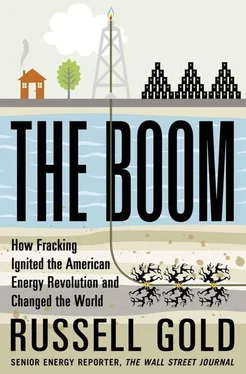This revolution is transforming the United States. To a remarkable extent, this once-obscure oil-field technique defines the nation’s economic and environmental future. Fracking has unleashed more oil and natural gas than anyone thought possible. It is providing an abundance of domestic energy, helping to drive a rebirth of manufacturing, and easing dependence on overseas energy peddlers. Accessing this energy requires tens of thousands of new wells, each fracked with enough water to fill several Olympic swimming pools and hundreds of gallons of chemicals. It also requires turning whole counties into industrial zones, complete with fleets of trucks, air quality concerns, a disruption of nature, and fear that water aquifers will be poisoned.
Modern societies run on fossil fuel. There is a direct connection between the number of jobs, cars, factories, and computers a country has—in short, its economic prosperity—and its energy consumption. Every day, the world consumes ninety million barrels of oil. Nearly one of every five of those barrels slakes the thirst of the United States’s economy and commuters. America is the most affluent nation in the history of the world, and it consumes more per person than any other major country ever has. Oil—and its main product, gasoline—has become a birthright of modern industrialized economies. We pull into gas stations and expect there to be enough gasoline to fill our tanks. Gasoline is everywhere, but it is invisible. It flows out of the pumps, through thick synthetic rubber hoses, and into our cars. You can smell it and occasionally see a hazy vapor. But you rarely, if ever, see it. Where does it come from? Not from the gas station on the side of the road. That is its last, brief stopover in a long journey.
Much of this energy comes from overseas. Without thinking about it, we have exported the dirty work of finding and developing oil fields, along with the environmental and social costs, to other nations. Until a few years ago, we planned to do the same for natural gas. But this dynamic is changing. Increasingly, crude oil consumed in the United States begins life in places such as North Dakota and South Texas. Fracking allows America to produce the gas we need—and much of the oil also—in our backyards. The promise and peril of energy production is coming home. The traditional energy system is being torn down and rebuilt. It’s an opportunity to take a hard look at the energy we use.
In 2008 a small Canadian energy advisory firm issued a report titled The “Shale Gas Revolution .” The name stuck and is now used widely, mostly by supporters of this new energy production who want to emphasize how big and pervasive the changes are. I also refer to it as a revolution, but for different reasons. It is a revolution because the old order is tumbling. King Coal’s reign as the nation’s predominant fuel for making electricity is tenuous, and even petroleum’s stranglehold on powering vehicles is weakening. As with many revolutions throughout history, once change is set in motion, the end result can be unexpected. Revolutions also create their own stories, creation myths, and hagiographies, as well as boogeymen. This book tells the story of fracking and how it rose from a minor oil-field tool to a world-changing technology. It is also an attempt, amid the tumult, to dispel some fictions that have risen to accepted “fact.”
———
The Farm isn’t part of my world anymore. When I hit my teenage years, spending a weekend with my parents and older sister had become excruciatingly boring. Completing thousand-piece jigsaw puzzles in a house without a television didn’t cut it.
As I was stumbling toward adulthood, in the 1980s, two men in faraway Texas and Oklahoma were going through their own changes. In time, they would help propel shale rocks from obscurity into the topic of boardroom presentations in the highest echelons of American capitalism. George Mitchell was a most unusual Texas oilman: liberal and an early convert to sustainable development. He created the Woodlands, north of Houston, to showcase that building a new community didn’t require bulldozing all the trees. At the same time, the eponymous Mitchell Energy & Development was one of the largest oil and gas companies in Houston, the world’s energy capital. Its most important holding was a gas field around Fort Worth.
Mitchell geologists noticed that every time their wells passed through shale rock in search of conventional pockets of oil and gas, instruments registered a significant gas presence. There was fossil fuel in the rocks, but it was as inaccessible as the sword in the stone from Arthurian legend. Mitchell’s long wells could reach the gas, but the company’s engineers had neither the tools nor the knowledge to get it out. Open up a textbook from that era and look up how to drill a well into shale and, if it mentioned the rocks at all, its advice was to look elsewhere. But in 1982 Mitchell Energy drilled the C. W. Slay #1 well to target the gas trapped inside the Barnett Shale, a thick geological formation that covers five thousand square miles, fanning out from Dallas to the west and south. Though the company had fracked wells in the past, it had never tried fracking shale rock. It worked, sort of. Gas flowed from the shale. But it was expensive. As a wildcat well, it was underwhelming. But as a science experiment, it showed promise.
Through the 1980s and into the 1990s, the company drilled a couple wells into the Barnett Shale each year. Mitchell’s engineers kept chipping away at this rock, trying to figure out how to force the shale to give up its gas. They pumped in heavy, gelatinous liquids they hoped would muscle their way in. Then, as they were ready to give up, a young engineer came up with a simple and elegant solution to cracking open the rock that would make these shale wells both less expensive and more bountiful. It was a new approach to fracking that used more horsepower and employed water, the Earth’s most abundant liquid. It was the beginning of the revolution. By then, Mitchell was nearly eighty years old. At the time, his children weren’t interested in the oil field, and he wanted to sell his company. But the rest of the industry remained skeptical about his shale wells. Wasn’t this new technique just a ploy by aging management to hype the company and get a buyer to pay top dollar?
———
When Mitchell was first trying to crack the shale puzzle, a different oilman was starting out. In 1981 Aubrey McClendon returned to his hometown of Oklahoma City after attending Duke University. Oklahoma City was in the midst of an energy boom. Global events led to a doubling and then a tripling of oil prices. He came home to prosperity, Cadillacs, and new skyscrapers. But he wasn’t a geologist or an engineer. He was an aspiring accountant who had graduated from college magna cum laude with a degree in history. He entered the energy industry and soon became a landman. His job was to convince landowners to sign leases to allow rigs to drill for oil and natural gas on their property. In 1982 a global recession led to a swift collapse in crude prices, and the city’s banks reeled from aggressive oil loans. The local Penn Square Bank failed. It was the first of more than one hundred Oklahoma bank failures. Bankruptcy auctioneers replaced those Caddys as the city’s unofficial symbol.
It must have been quite an education, unlike any that McClendon had received at Duke. He witnessed the boom-and-bust nature of oil and gas. He saw the riches available if you could time the rise and fall of volatile commodities correctly, and he also saw how money made all this possible. In time, he would go on to found Chesapeake Energy and become a convert to the potential of shale gas. He would do more than anyone else to promote shale gas. He was part pied piper, part early adopter, and part rapacious capitalist. Those dense rocks that resemble an old-fashioned chalkboard would make him a billionaire, before he nearly lost it all. McClendon would use his energy wealth to advance his energy and political agenda, assemble a world-class wine collection, and uproot the Seattle SuperSonics of the National Basketball Association, bringing his hometown its first professional sports franchise, renamed the Oklahoma City Thunder. More than anyone else, he would usher in an era of energy abundance.
Читать дальше












